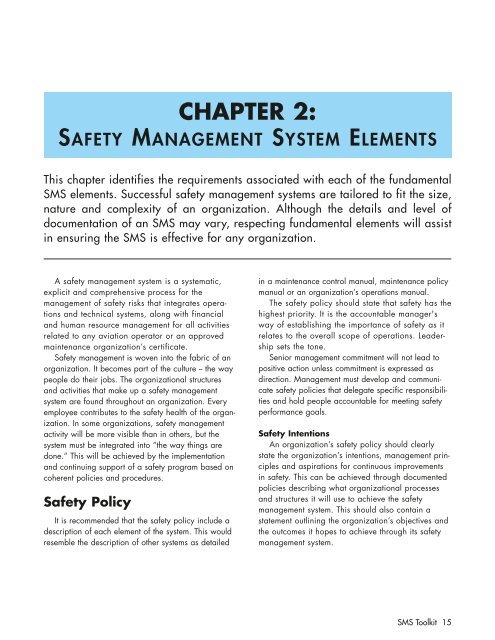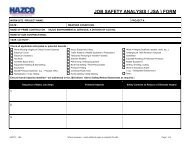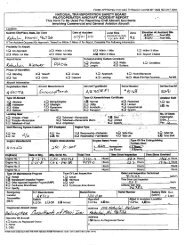International Helicopter Safety Team Safety Management System Toolkit
IHST - Safety Management Toolkit - Skybrary
IHST - Safety Management Toolkit - Skybrary
- No tags were found...
You also want an ePaper? Increase the reach of your titles
YUMPU automatically turns print PDFs into web optimized ePapers that Google loves.
CHAPTER 2:<br />
SAFETY MANAGEMENT SYSTEM ELEMENTS<br />
This chapter identifies the requirements associated with each of the fundamental<br />
SMS elements. Successful safety management systems are tailored to fit the size,<br />
nature and complexity of an organization. Although the details and level of<br />
documentation of an SMS may vary, respecting fundamental elements will assist<br />
in ensuring the SMS is effective for any organization.<br />
A safety management system is a systematic,<br />
explicit and comprehensive process for the<br />
management of safety risks that integrates operations<br />
and technical systems, along with financial<br />
and human resource management for all activities<br />
related to any aviation operator or an approved<br />
maintenance organization’s certificate.<br />
<strong>Safety</strong> management is woven into the fabric of an<br />
organization. It becomes part of the culture -- the way<br />
people do their jobs. The organizational structures<br />
and activities that make up a safety management<br />
system are found throughout an organization. Every<br />
employee contributes to the safety health of the organization.<br />
In some organizations, safety management<br />
activity will be more visible than in others, but the<br />
system must be integrated into “the way things are<br />
done.” This will be achieved by the implementation<br />
and continuing support of a safety program based on<br />
coherent policies and procedures.<br />
<strong>Safety</strong> Policy<br />
It is recommended that the safety policy include a<br />
description of each element of the system. This would<br />
resemble the description of other systems as detailed<br />
in a maintenance control manual, maintenance policy<br />
manual or an organization’s operations manual.<br />
The safety policy should state that safety has the<br />
highest priority. It is the accountable manager's<br />
way of establishing the importance of safety as it<br />
relates to the overall scope of operations. Leadership<br />
sets the tone.<br />
Senior management commitment will not lead to<br />
positive action unless commitment is expressed as<br />
direction. <strong>Management</strong> must develop and communicate<br />
safety policies that delegate specific responsibilities<br />
and hold people accountable for meeting safety<br />
performance goals.<br />
<strong>Safety</strong> Intentions<br />
An organization’s safety policy should clearly<br />
state the organization’s intentions, management principles<br />
and aspirations for continuous improvements<br />
in safety. This can be achieved through documented<br />
policies describing what organizational processes<br />
and structures it will use to achieve the safety<br />
management system. This should also contain a<br />
statement outlining the organization’s objectives and<br />
the outcomes it hopes to achieve through its safety<br />
management system.<br />
SMS <strong>Toolkit</strong> 15







